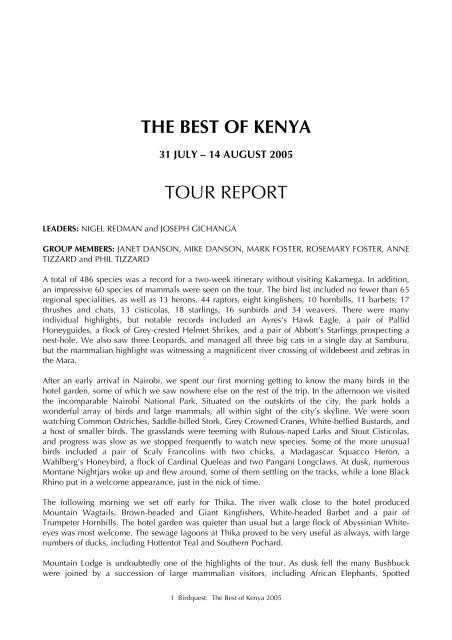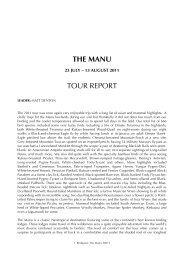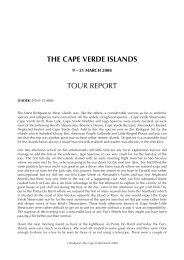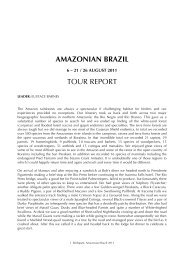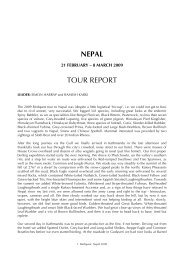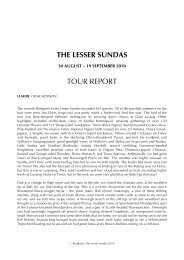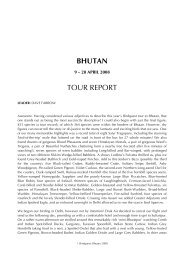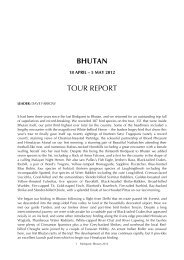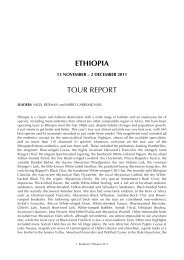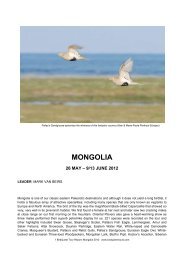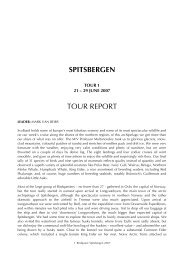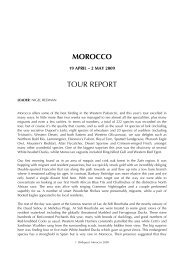Download Full Tour Report 295kb - Birdquest
Download Full Tour Report 295kb - Birdquest
Download Full Tour Report 295kb - Birdquest
You also want an ePaper? Increase the reach of your titles
YUMPU automatically turns print PDFs into web optimized ePapers that Google loves.
THE BEST OF KENYA<br />
31 JULY – 14 AUGUST 2005<br />
TOUR REPORT<br />
LEADERS: NIGEL REDMAN and JOSEPH GICHANGA<br />
GROUP MEMBERS: JANET DANSON, MIKE DANSON, MARK FOSTER, ROSEMARY FOSTER, ANNE<br />
TIZZARD and PHIL TIZZARD<br />
A total of 486 species was a record for a two-week itinerary without visiting Kakamega. In addition,<br />
an impressive 60 species of mammals were seen on the tour. The bird list included no fewer than 65<br />
regional specialities, as well as 13 herons, 44 raptors, eight kingfishers, 10 hornbills, 11 barbets, 17<br />
thrushes and chats, 13 cisticolas, 18 starlings, 16 sunbirds and 34 weavers. There were many<br />
individual highlights, but notable records included an Ayres’s Hawk Eagle, a pair of Pallid<br />
Honeyguides, a flock of Grey-crested Helmet Shrikes, and a pair of Abbott’s Starlings prospecting a<br />
nest-hole. We also saw three Leopards, and managed all three big cats in a single day at Samburu,<br />
but the mammalian highlight was witnessing a magnificent river crossing of wildebeest and zebras in<br />
the Mara.<br />
After an early arrival in Nairobi, we spent our first morning getting to know the many birds in the<br />
hotel garden, some of which we saw nowhere else on the rest of the trip. In the afternoon we visited<br />
the incomparable Nairobi National Park. Situated on the outskirts of the city, the park holds a<br />
wonderful array of birds and large mammals, all within sight of the city’s skyline. We were soon<br />
watching Common Ostriches, Saddle-billed Stork, Grey Crowned Cranes, White-bellied Bustards, and<br />
a host of smaller birds. The grasslands were teeming with Rufous-naped Larks and Stout Cisticolas,<br />
and progress was slow as we stopped frequently to watch new species. Some of the more unusual<br />
birds included a pair of Scaly Francolins with two chicks, a Madagascar Squacco Heron, a<br />
Wahlberg’s Honeybird, a flock of Cardinal Queleas and two Pangani Longclaws. At dusk, numerous<br />
Montane Nightjars woke up and flew around, some of them settling on the tracks, while a lone Black<br />
Rhino put in a welcome appearance, just in the nick of time.<br />
The following morning we set off early for Thika. The river walk close to the hotel produced<br />
Mountain Wagtails, Brown-headed and Giant Kingfishers, White-headed Barbet and a pair of<br />
Trumpeter Hornbills. The hotel garden was quieter than usual but a large flock of Abyssinian Whiteeyes<br />
was most welcome. The sewage lagoons at Thika proved to be very useful as always, with large<br />
numbers of ducks, including Hottentot Teal and Southern Pochard.<br />
Mountain Lodge is undoubtedly one of the highlights of the tour. As dusk fell the many Bushbuck<br />
were joined by a succession of large mammalian visitors, including African Elephants, Spotted<br />
1 <strong>Birdquest</strong>: The Best of Kenya 2005
Hyaena and Blotched Genet. When dawn broke we were up and ready for the montane specialities<br />
to show themselves. By breakfast, we had seen a good many birds from the roof of the lodge. It was a<br />
bumper year for starlings, and we found both Kenrick’s and Waller’s without difficulty and, more<br />
unusually, also several Sharpe’s. But the biggest surprise was a pair of Abbott’s Starlings which<br />
appeared to be attending a nest-hole right opposite the lodge. After breakfast, a walk in the forest<br />
produced some notable sightings including great views of Hartlaub’s Turacos, White-headed Wood-<br />
Hoopoes, Fine-banded Woodpecker, two pairs of White-starred Robins and a juvenile, a splendid<br />
Brown-chested Alethe, Black-throated Apalis, White-browed Crombec, White-tailed Crested<br />
Flycatcher, a nuthatch-like Brown-capped Weaver, and a stunning Oriole-Finch. We birded slowly<br />
down the road from the Mountain Lodge, adding Narina Trogon, White-eared Barbet, and Purplethroated<br />
and Grey Cuckoo Shrikes. Overhead we saw both Crowned and Wahlberg’s Eagles. The<br />
delightful gardens at Naro Moru provided a refreshing break on our journey north, with several more<br />
sunbirds including Tacazze, and incredibly close-up views of two African Harrier-Hawks.<br />
Moving away from the highlands, the adjoining reserves of Samburu and Buffalo Springs were a big<br />
contrast, not least the dry, hot weather! Here we found a wide selection of new species for the trip<br />
and plenty of big mammals. Raptors were in evidence as always, and during our two days we saw no<br />
fewer than 24 species, including frequent Bateleurs, a huge Martial Eagle, Palm-nut Vulture, a pair of<br />
Verreaux’s Eagles, elegant Secretary Birds, and several pairs of diminutive Pygmy Falcons. Somali<br />
Ostriches performed well, a variety of bustards and sandgrouse were found close to the track and the<br />
gorgeous Golden-breasted Starlings put on a vivid display for us this year. There were many other<br />
highlights but the lines of Vulturine Guineafowl making their way to water, the pastel-coloured<br />
Somali Bee-eaters and ‘blood-stained’ Rosy-patched Bush Shrikes all take some beating. Herds of<br />
African Elephants, upright Gerenuks and finely-striped Grevy’s Zebras never fail to delight, but it was<br />
the big cats which almost stole the show. A Leopard visited the bait at night across the river from our<br />
lodge on two nights, and during the day we found both Cheetah (twice) and Lion. We actually<br />
managed to see all three big cats in a single day, which is not something that happens very often.<br />
Returning to the highlands, we drove up the lower slopes of Mount Kenya once again. Finally, we<br />
found plenty of showy Golden-winged Sunbirds, plus a distant Mountain Buzzard and an Ayres’s<br />
Hawk Eagle, as well as an unexpected Red-throated Wryneck. Later we found a roosting Cape Eagle<br />
Owl in a quarry, and a flock of Slender-billed Starlings at Thomson’s Falls. Eventually we reached<br />
Lake Nakuru in the Rift Valley. Here the shimmering flocks of hundreds of thousands of flamingos<br />
provided an unforgettable spectacle while squadrons of pelicans flew in and out with great regularity.<br />
There were waders, ducks and terns to sift through along the shoreline, while the surrounding acacia<br />
woodland added a number of new species such as Hildebrandt’s Francolin, Scaly-throated<br />
Honeyguide and a party of the very localized Grey-crested Helmet Shrikes. An African Cuckoo-Hawk<br />
was a surprise find, as was an early-morning pride of Lions which we had to ourselves. Amongst the<br />
many mammals around the lake, we found both White and Black Rhinos.<br />
After a stop for Black-headed Plover and White-fronted Bee-eater, we reached Lake Baringo. The<br />
hotel gardens were very birdy as always, with gaudy Red and Yellow Barbets nesting in the termite<br />
towers and a host of weavers at the bird table. The lake itself was infested with crocodiles and<br />
wallowing hippos, while stunning Yellow-crowned Bishops buzzed around the edges. A visit to<br />
Baringo is not complete without a visit to the cliffs and here we found White-faced Scops Owl, and<br />
both Black-and-white and Great Spotted Cuckoos amongst the usual specialities. Nearby, we were<br />
shown a splendid pair of roosting Spotted Eagle Owls, and in the bushy areas several other nocturnal<br />
species including Spotted Thick-knee, Heuglin’s Courser and Slender-tailed Nightjar – all seen during<br />
the day.<br />
The journey to the Mara took us through Kericho, and here we found African Black Duck, an obliging<br />
Cinnamon Bracken Warbler and several gorgeous Abyssinian Crimsonwings. There were also a<br />
2 <strong>Birdquest</strong>: The Best of Kenya 2005
number of western species that we don’t usually find on our circuit, including Angola Swallow,<br />
Black-collared Apalis, White-chinned Prinia, Mackinnon’s Fiscal and Stuhlmann’s Starling.<br />
When we arrived at Kichwa Tembo, at the western end of the Mara, we found ourselves<br />
unexpectedly upgraded to the exclusive Bateleur Camp. This luxurious camp, where all nine tents<br />
have four-poster beds and every possible luxury, was to be our base for the next three days. The<br />
gardens of Kichwa Tembo hold a wonderful array of birds, and the highlights this year included a nest<br />
of a pair of Woolly-necked Storks (with one chick), both Ross’s and Schalow’s Turacos, Black-andwhite-casqued<br />
Hornbills, a pair of obliging Pallid Honeyguides (a rarity here) and African Blue<br />
Flycatchers. Nearby, we had amazing views of Trilling Cisticolas, Red-throated Tit, African<br />
Moustached Warbler and White-necked Ravens. The various wetland areas were searched for such<br />
species as Rufous-bellied Herons, Spur-winged Geese and Long-toed Plovers, while the open plains<br />
held Red-necked Spurfowl, a single Black-bellied Bustard and several gorgeous Rosy-breasted<br />
Longclaws. Unusual mammals in this area included Oribi and Side-striped Jackal. But the real<br />
highlight of our stay came late one afternoon when, having watched a fine if somewhat confusing<br />
African Hobby for half an hour, a magnificent Leopard got up from the grass in front of us and calmly<br />
wandered off! This was indeed one of those very special moments.<br />
The drive across the Mara was all that it should have been. On reaching a particular point on the<br />
Mara River, huge herds of Wildebeeste stretched from one horizon to another, moving slowly around,<br />
continuously feeding and braying. It was the stuff of wildlife documentaries but we were not alone in<br />
admiring the spectacle; there were many other tourist buses in the area, all jostling for a good view<br />
and hoping to see a river crossing. After a fraught two-hour wait, and several false starts, one brave<br />
individual took the plunge and the rest followed. We were treated to a magnificent river crossing<br />
(mostly wildebeest, but also some zebras), and on this occasion no animals were lost to crocodiles or<br />
lions. Several old carcases from previous encounters were being picked clean by flocks of<br />
argumentative vultures, mainly African White-backed but including an unusually large number of<br />
Rüppell’s Griffons this year. As we continued our journey a Grey Kestrel was a welcome addition to<br />
the list.<br />
At the eastern end of the park, we stayed overnight at Siana Springs. A night drive outside the park<br />
boundary proved to be productive. Several Spotted Thick-knees and a Dusky Nightjar were the<br />
ornithological highlights, but the mammals were the main draw. Kangaroo-like Spring Hares were<br />
comical as always, and several Bat-eared Foxes, Spotted Hyaenas and a Common Genet were found.<br />
In the larger acacias, tiny Senegal Galagos leapt rapidly around in the canopy. The following morning<br />
we successfully searched the surrounding area for the striking and highly localized Magpie Shrike,<br />
and added two more cisticolas to our list: Long-tailed and Croaking. Soon it was time to head back to<br />
Nairobi, but the return journey provided a few more treats with Greater Kestrel, Two-banded Courser,<br />
a pair of Yellow-throated Sandgrouse and four magnificent Southern Ground Hornbills by the<br />
roadside.<br />
In two weeks, we really had seen the best that Kenya has to offer – a long bird list, and some<br />
spectacular mammals, with some of the greatest wildlife spectacles on earth. What more could one<br />
want?<br />
3 <strong>Birdquest</strong>: The Best of Kenya 2005
SYSTEMATIC LIST<br />
Species which were heard but not seen are indicated by the symbol (H).<br />
Species which were not personally recorded by the leaders are indicated by the symbol (NL).<br />
STRUTHIONIDAE<br />
Common Ostrich Struthio camelus: Small numbers in Nairobi NP, Nakuru, Baringo, and the Mara.<br />
Somali Ostrich Struthio molybdophanes: Several sightings in Buffalo Springs. There is significant<br />
DNA evidence that suggests that this distinctive form is a different species from the pinknecked<br />
form above.<br />
PODICIPEDIDAE<br />
Little Grebe Tachybaptus ruficollis: Good numbers at Thika sewage ponds and at Nakuru; a few<br />
others elsewhere.<br />
PELECANIDAE<br />
Great White Pelican Pelecanus onocrotalus: About 2000 at Lake Nakuru were a truly spectacular<br />
sight; a few more at Baringo.<br />
Pink-backed Pelican Pelecanus rufescens: Two singles on roadside pools were the only sightings.<br />
PHALACROCORACIDAE<br />
White-breasted Cormorant Phalacrocorax lucidus: Good numbers at Nakuru and Baringo.<br />
Long-tailed Cormorant Phalacrocorax africanus: Small numbers at several sites.<br />
ARDEIDAE<br />
Black-crowned Night Heron Nycticorax nycticorax: Several at a dam near Nyahururu and at Baringo.<br />
Cattle Egret Bubulcus ibis: Common and widespread.<br />
Little Egret Egretta garzetta: Just a few at Nakuru, Baringo and the Mara.<br />
Squacco Heron Ardeola ralloides: Several at Nakuru, Baringo and the Mara.<br />
Rufous-bellied Heron Ardeola rufiventris: Six birds seen in the Mara.<br />
Green-backed Heron (Striated Heron) Butorides striatus: Singles at Samburu and Baringo.<br />
Yellow-billed Egret (Intermediate Egret) Mesophoyx intermedia: Small numbers, including a dozen at<br />
Baringo.<br />
Great Egret Casmerodius albus: About 20 at Nakuru, and a few more at Baringo.<br />
Grey Heron Ardea cinerea: Widespread in small numbers.<br />
Purple Heron Ardea purpurea: A single near Nyahururu was the only sighting.<br />
Goliath Heron Ardea goliath: A monster of a heron; surprisingly, one at the Musiara Swamp was the<br />
only sighting this year.<br />
Black-headed Heron Ardea melanocephala: Widespread, with good numbers in the Mara; usually in<br />
drier habitats than Grey Heron.<br />
SCOPIDAE<br />
Hamerkop Scopus umbretta: A common bird which builds such huge nests.<br />
CICONIIDAE<br />
Woolly-necked Stork Ciconia episcopus: After a single on the journey to the Mara, we found a nest<br />
with a pair and one chick on the edge of our camp.<br />
Saddle-billed Stork Ephippiorhynchus senegalensis: Singles in Nairobi NP and Nakuru, and three<br />
pairs (two with young) in the Mara – a good showing for this spectacular bird.<br />
Marabou Stork Leptoptilos crumeniferus: Widespread and common.<br />
Yellow-billed Stork Mycteria ibis: Commonly seen.<br />
4 <strong>Birdquest</strong>: The Best of Kenya 2005
THRESKIORNITHIDAE<br />
Sacred Ibis Threskiornis aethiopicus: Widespread and common.<br />
Hadada Ibis Bostrychia hagedash: Common and noisy.<br />
Glossy Ibis Plegadis falcinellus: A single in Nairobi NP and about 20 at Nakuru.<br />
African Spoonbill Platalea alba: Singles in Nairobi NP and the Mara, and about 20 at Nakuru.<br />
PHOENICOPTERIDAE<br />
Greater Flamingo Phoenicopterus roseus: Small numbers amongst the Lessers at Nakuru, and a few at<br />
Baringo.<br />
Lesser Flamingo Phoeniconaias minor: Huge numbers at Lake Nakuru, perhaps as many as a million<br />
birds.<br />
ANATIDAE<br />
White-faced Whistling Duck Dendrocygna viduata: Small numbers at Thika and Baringo.<br />
Spur-winged Goose Plectropterus gambensis: After a bit of searching, Joseph triumphantly found a<br />
pair in the Mara.<br />
Egyptian Goose Alopochen aegyptiacus: Seen almost daily and at all altitudes.<br />
African Black Duck Anas sparsa: One on a pond near Kericho was a welcome surprise.<br />
Cape Teal Anas capensis: A total of 11 at Nakuru.<br />
Yellow-billed Duck Anas undulata: Small numbers at several locations.<br />
Red-billed Teal (Red-billed Duck) Anas erythrorhyncha: About 100 at Thika, but none elsewhere.<br />
Hottentot Teal Anas hottentota: Just a single at Thika.<br />
Southern Pochard Netta erythrophthalma: Eight at Thika sewage lagoons, but a staggering 120<br />
counted at Nakuru.<br />
SAGITTARIIDAE<br />
Secretary Bird Sagittarius serpentarius: Eight seen at Buffalo Springs, and another five in the Mara.<br />
PANDIONIDAE<br />
Osprey Pandion haliaetus: One flying over at Samburu.<br />
ACCIPITRIDAE<br />
African Cuckoo-Hawk Aviceda cuculoides: Great views of one at Nakuru – this species is always a<br />
bonus.<br />
Black-shouldered Kite Elanus caeruleus: Frequent sightings.<br />
Yellow-billed Kite Milvus aegyptius: Seen mainly around Nairobi.<br />
Egyptian Vulture Neophron percnopterus: Two adults at Samburu.<br />
Hooded Vulture Necrosyrtes monachus: Four at Samburu, and three more in the Mara.<br />
African White-backed Vulture Gyps africanus: Commonest scavenger; largest numbers at Nairobi<br />
NP, Samburu and the Mara.<br />
Rüppell’s Griffon Vulture Gyps rueppellii: A few at Samburu, Nakuru and the Mara. This species is<br />
usually uncommon in Kenya but, remarkably, at one kill in the Mara there were no fewer<br />
than 40 Rüppell’s where they outnumbered the White-backed.<br />
Lappet-faced Vulture Torgos tracheliotus: Singles at Nairobi NP, Samburu and Nakuru, but up to<br />
seven per day in the Mara.<br />
White-headed Vulture Trigonoceps occipitalis: Singles in Samburu and the Mara.<br />
Black-chested Snake Eagle Circaetus pectoralis: Several sightings in the Mara.<br />
Brown Snake Eagle Circaetus cinereus: Singles each day in the Mara.<br />
Banded Snake Eagle Circaetus cinerascens: Two birds seen near the Mara River.<br />
Bateleur Terathopius ecaudatus: A common and most distinctive raptor, seen daily at Buffalo<br />
Springs/Samburu and the Mara.<br />
5 <strong>Birdquest</strong>: The Best of Kenya 2005
African Harrier-Hawk Polyboroides typus: Several sightings, but the amazing views of a pair at Naro<br />
Moru were the most memorable.<br />
African Marsh Harrier Circus ranivorus: One at the marsh near Governors Camp in the Mara.<br />
Gabar Goshawk Micronisus gabar: Singles on four occasions.<br />
Dark Chanting Goshawk Melierax metabates: Several sightings at Baringo and the Mara.<br />
Eastern Pale Chanting Goshawk Melierax poliopterus: Excellent views at Buffalo Springs/Samburu.<br />
African Goshawk Accipiter tachiro: Singles at Thika and Siana Springs.<br />
Shikra Accipiter badius: Several sightings in Buffalo Springs, Baringo and Siana Springs<br />
Little Sparrowhawk Accipiter minullus: One seen briefly by Phil and Nigel at Siana Springs.<br />
Great Sparrowhawk Accipiter melanoleucus: Singles at Mountain Lodge and Siana Springs; both<br />
were young birds and the latter showed well in the garden.<br />
Mountain Buzzard Buteo oreophilus: A single distant bird on Mount Kenya.<br />
Augur Buzzard Buteo augur: A common but handsome resident species.<br />
African Fish Eagle Haliaeetus vocifer: One of Africa’s most familiar birds.<br />
Palm-nut Vulture (Vulturine Fish Eagle) Gypohierax angolensis: A single bird at Samburu as usual.<br />
Tawny Eagle Aquila rapax: Small numbers at several sites; most numerous in Samburu.<br />
Steppe Eagle Aquila nipalensis: An immature bird in the Mara had presumably over-summered<br />
Wahlberg’s Eagle Aquila wahlbergi: A single at the base of Mt Kenya, and three more in the Mara.<br />
Verreaux’s Eagle Aquila verreauxii: Three birds seen at Samburu and a single in the Mara was a good<br />
showing for this striking species.<br />
African Hawk Eagle Hieraaetus spilogaster: A pair was seen well at Samburu.<br />
Ayres’s Hawk Eagle Hieraaetus ayresii: A single on Mt Kenya was a bonus.<br />
Long-crested Eagle Lophaetus occipitalis: Several sightings of this somewhat comical bird.<br />
African Crowned Eagle (Crowned Eagle) Stephanoaetus coronatus: Three birds on the slopes of<br />
Mount Kenya, and a pair (including one perched) at Thomson’s Falls.<br />
Martial Eagle Polemaetus bellicosus: Singles of this huge eagle in Buffalo Springs and the Mara.<br />
FALCONIDAE<br />
Pygmy Falcon Polihierax semitorquatus: Ten birds seen in Buffalo Springs/Samburu, mostly in pairs.<br />
This delightful species uses unoccupied nests of White-headed Buffalo Weavers.<br />
Lanner Falcon Falco biarmicus: Pairs seen at Samburu and Baringo and another single on a journey.<br />
Peregrine Falcon Falco peregrinus: A single flyover on the journey to the Mara.<br />
African Hobby Falco cuvieri: Great views of a single in the Mara that at the time we thought<br />
appeared similar to a Taita Falcon F. fasciinucha.<br />
Greater Kestrel (White-eyed Kestrel) Falco rupicoloides: A single at Kedong.<br />
Grey Kestrel Falco ardosiaceus: One in the Mara, and a pair on the journey back to Nairobi.<br />
Common Kestrel Falco tinnunculus: Two singles on journeys were the only records this year.<br />
PHASIANIDAE<br />
Harlequin Quail Coturnix delegorguei (H): One heard by the roadside near Baringo.<br />
Coqui Francolin Francolinus coqui: Several small groups in the Mara.<br />
Crested Francolin Francolinus sephaena: Fairly common at Buffalo Springs.<br />
Scaly Francolin Francolinus squamatus: A pair plus two chicks in Nairobi NP was unexpected.<br />
Hildebrandt’s Francolin Francolinus hildebrandti: Great views of three at Lake Nakuru.<br />
Red-necked Spurfowl Francolinus afer: Frequently encountered in the Mara.<br />
Yellow-necked Spurfowl Francolinus leucoscepus: A common but pleasing sight at Buffalo<br />
Springs/Samburu.<br />
NUMIDIDAE<br />
Vulturine Guineafowl Acryllium vulturinum: Several large groups of this stunning bird gave much<br />
delight at Buffalo Springs/Samburu.<br />
Helmeted Guineafowl Numida meleagris: Common and widespread.<br />
6 <strong>Birdquest</strong>: The Best of Kenya 2005
RALLIDAE<br />
Black Crake Amaurornis flavirostris: A few brief sightings.<br />
African Swamphen Porphyrio madagascariensis: One at a roadside dam near Nyahururu.<br />
Common Moorhen Gallinula chloropus: Small numbers at several sites.<br />
Red-knobbed Coot (Crested Coot) Fulica cristata: Small numbers at several sites.<br />
GRUIDAE<br />
Grey Crowned Crane Balearica regulorum: Several sightings of this exotic species.<br />
OTIDIDAE<br />
Kori Bustard Ardeotis kori: Two singles at Buffalo Springs and another on the Solio Ranch. Four birds<br />
seen on the journey back from the Mara.<br />
Buff-crested Bustard Eupodotis gindiana: A total of eight seen at Buffalo Springs.<br />
White-bellied Bustard Eupodotis senegalensis: Several small groups seen, mostly in pairs<br />
Black-bellied Bustard Eupodotis melanogaster: A single in the Mara was the only record.<br />
JACANIDAE<br />
African Jacana Actophilornis africanus: Several sightings in various places.<br />
RECURVIROSTRIDAE<br />
Black-winged Stilt Himantopus himantopus: A pair at Thika and about 30 at Nakuru.<br />
BURHINIDAE<br />
Water Thick-knee (Water Dikkop) Burhinus vermiculatus: Two on the river at Samburu.<br />
Spotted Thick-knee (Spotted Dikkop) Burhinus capensis: A pair during the day at Baringo, and three<br />
on the night drive at Siana Springs.<br />
GLAREOLIDAE<br />
Two-banded Courser Rhinoptilus africanus: After much searching, one spanking individual found by<br />
Mark on the journey back to Nairobi.<br />
Heuglin’s Courser Rhinoptilus cinctus: A pair at Baringo was surely one of the best birds of the trip<br />
for most.<br />
Somali Courser Cursorius somaliensis: Surprisingly elusive at Buffalo Springs this year, but we found<br />
seven on our final attempt. This is now a well accepted split from Cream-coloured<br />
Courser C. cursor.<br />
CHARADRIIDAE<br />
Long-toed Plover Vanellus crassirostris: Five at a pool in the Mara.<br />
Blacksmith Plover Vanellus armatus: An attractive and widespread resident.<br />
Spur-winged Plover Vanellus spinosus: A common bird.<br />
Black-headed Plover Vanellus tectus: Three seen on the journey to Baringo.<br />
Black-winged Plover Vanellus melanopterus: Two roadside birds in the highlands and four more at<br />
Solio.<br />
Crowned Plover Vanellus coronatus: A common and noisy plover.<br />
African Wattled Plover Vanellus senegallus: A particularly elegant species; four seen in the Mara.<br />
Kittlitz’s Plover Charadrius pecuarius: Good views at Nakuru, but only one pair this year.<br />
Three-banded Plover Charadrius tricollaris: Several sightings, notably at Thika where there were 15<br />
birds present.<br />
SCOLOPACIDAE<br />
Little Stint Calidris minuta: Four in Nairobi NP and about 15 at Nakuru.<br />
Curlew Sandpiper Calidris ferruginea: Four at Nakuru.<br />
7 <strong>Birdquest</strong>: The Best of Kenya 2005
Ruff Philomachus pugnax: Several at Thika and the Mara, and about 20 at Nakuru.<br />
Marsh Sandpiper Tringa stagnatilis: A single at Nakuru was the only record.<br />
Common Greenshank Tringa nebularia: Several sightings.<br />
Green Sandpiper Tringa ochropus: Just two seen and another heard.<br />
Wood Sandpiper Tringa glareola: About 20 at Thika, and quite a few others at various locations.<br />
Common Sandpiper Actitis hypoleucos: Widespread in small numbers.<br />
LARIDAE<br />
Grey-headed Gull Larus cirrocephalus: Only a few at Nakuru this year.<br />
Whiskered Tern Chlidonias hybridus: Just two at Nakuru.<br />
White-winged Tern (White-winged Black Tern) Chlidonias leucopterus: A few at Thika and about 20<br />
at Nakuru – not a very good showing.<br />
PTEROCLIDAE<br />
Chestnut-bellied Sandgrouse Pterocles exustus: Small numbers at Buffalo Springs; a pair with three<br />
chicks gave amazing roadside views.<br />
Black-faced Sandgrouse Pterocles decoratus: An attractive sandgrouse at Buffalo Springs, often in<br />
pairs; a day-total of 200 was exceptional.<br />
Lichtenstein’s Sandgrouse Pterocles lichtensteinii: Good views of a single female at Buffalo Springs.<br />
Yellow-throated Sandgrouse Pterocles gutturalis: Excellent views of a pair on the way back from the<br />
Mara.<br />
COLUMBIDAE<br />
African Green Pigeon Treron calva: About 20 at Thika and a few more in the Mara.<br />
Tambourine Dove Turtur tympanistria: One heard at Thika and a couple at Mountain Lodge.<br />
Emerald-spotted Wood Dove Turtur chalcospilos: A common dry-country dove.<br />
Blue-spotted Wood Dove Turtur afer: Small numbers in woodland in the Mara region.<br />
Namaqua Dove Oena capensis: Small numbers in dry country.<br />
Eastern Bronze-naped Pigeon Columba delegorguei: About 25 at Mountain Lodge and on the journey<br />
down.<br />
Olive Pigeon Columba arquatrix: A few seen at Mountain Lodge.<br />
Speckled Pigeon Columba guinea: Widespread.<br />
Feral Pigeon (Rock Dove) Columba livia: A few in Nairobi and Thika.<br />
Red-eyed Dove Streptopelia semitorquata: A common highland species. Sings “I am a Red-eyed<br />
Dove”.<br />
African Mourning Dove Streptopelia decipiens: Particularly common in the Samburu/Buffalo Springs<br />
and Baringo areas; a dry country species.<br />
Ring-necked Dove Streptopelia capicola: Abundant and widespread.<br />
Dusky Turtle Dove Streptopelia lugens: Several sightings in highland areas.<br />
Laughing Dove Streptopelia senegalensis: Abundant dry country dove.<br />
PSITTACIDAE<br />
Red-fronted Parrot Poicephalus gulielmi: Several fly-overs at Mountain Lodge, but some good<br />
perched views eventually.<br />
Brown Parrot Poicephalus meyeri: Several sightings at Baringo and the Mara.<br />
African Orange-bellied Parrot Poicephalus rufiventris: Several seen well at Buffalo Springs.<br />
[Yellow-collared/Fischer’s Lovebird Agapornis personatus x fischeri: Several hybrid lovebirds seen in<br />
Nairobi NP and Thika.]<br />
MUSOPHAGIDAE<br />
Ross’s Turaco Tauraco rossae: Prolonged breathtaking views of a pair in the Mara, and another single<br />
in Kichwa Tembo.<br />
8 <strong>Birdquest</strong>: The Best of Kenya 2005
Schalow’s Turaco Tauraco schalowi: Several seen in the Mara.<br />
Hartlaub’s Turaco Tauraco hartlaubi: Great views at Mountain Lodge and Naro Moru.<br />
Bare-faced Go-away Bird Corythaixoides personatus: Frequent in the Mara, especially in the Siana<br />
Springs area.<br />
White-bellied Go-away Bird Corythaixoides leucogaster: Common at Samburu/Buffalo Springs and in<br />
the Baringo area; also a few in Nairobi NP.<br />
CUCULIDAE<br />
Black-and-white Cuckoo (Jacobin Cuckoo) Oxylophus jacobinus: Two singles at Baringo.<br />
Great Spotted Cuckoo Clamator glandarius: One bird seen at Baringo.<br />
Black Cuckoo Cuculus clamosus (H): Two birds heard at Nakuru.<br />
Red-chested Cuckoo Cuculus solitarius: Several seen and heard at Nakuru and Baringo.<br />
African Cuckoo Cuculus gularis: One seen well south of Baringo.<br />
Klaas’s Cuckoo Chrysococcyx klaas: Frequent sightings at various places.<br />
Diederik Cuckoo (Didric Cuckoo) Chrysococcyx caprius: Fairly common, especially at Nakuru and<br />
Baringo.<br />
White-browed Coucal Centropus superciliosus: Singles seen frequently.<br />
STRIGIDAE<br />
Northern White-faced Scops Owl Otus leucotis: One seen well by the cliffs at Baringo, thanks to our<br />
local ‘scout’.<br />
Cape Eagle Owl Bubo capensis: A superb bird roosting in a quarry at the “Scops Owl” sign! The local<br />
subspecies is usually known as Mackinder’s Eagle Owl.<br />
Spotted Eagle Owl Bubo africanus: A pair on some small cliffs at Baringo provided superb views.<br />
These dark-eyed birds are of the cinerascens race which is sometimes split off as a<br />
separate species (called Vermiculated Eagle Owl).<br />
Verreaux’s Eagle-Owl Bubo lacteus: Singles at Mountain Lodge and Buffalo Springs (twice); one of<br />
the latter had the remains of a Spur-winged Plover on its roosting branch. Two were seen<br />
each day in the garden at Baringo, providing superb photographic opportunities.<br />
Pearl-spotted Owlet Glaucidium perlatum: Seen daily at Samburu, invariably in response to the tape.<br />
Singles also heard at Baringo and Siana Springs.<br />
CAPRIMULGIDAE<br />
Montane Nightjar Caprimulgus poliocephalus: About 15 seen at dusk in Nairobi NP and others heard<br />
at Mountain Lodge.<br />
Dusky Nightjar Caprimulgus fraenatus: One seen well on the ground by Nigel on the night drive at<br />
Siana Springs.<br />
Slender-tailed Nightjar Caprimulgus clarus: Several seen at dusk each evening at Baringo, and<br />
another at Siana Springs.<br />
APODIDAE<br />
African Palm Swift Cypsiurus parvus: Very common at Samburu/Buffalo Springs. Also seen in Nairobi<br />
and surroundings.<br />
African Black Swift Apus barbatus: At least one on the way back from the Mara.<br />
Nyanza Swift Apus niansae: Small numbers at several places.<br />
Mottled Swift Apus aequatorialis: Eight seen at Samburu.<br />
White-rumped Swift Apus caffer: About 10 at Baringo.<br />
Horus Swift Apus horus: Six seen well at Nakuru.<br />
Little Swift Apus affinis: A common bird, with some large flocks at park entrances and bridges, most<br />
notably 400 at Samburu.<br />
9 <strong>Birdquest</strong>: The Best of Kenya 2005
COLIIDAE<br />
Speckled Mousebird Colius striatus: Common and widespread.<br />
White-headed Mousebird Colius leucocephalus: Just a single at Samburu.<br />
Blue-naped Mousebird Urocolius macrourus: A dry country species which was particularly common<br />
in Samburu/Buffalo Springs and in the Baringo area.<br />
TROGONIDAE<br />
Narina Trogon Apaloderma narina: One bird seen on the journey down from Mountain Lodge.<br />
ALCEDINIDAE<br />
Grey-headed Kingfisher (Chestnut-bellied Kingfisher) Halcyon leucocephala: Showy and colourful;<br />
particularly common at Samburu/Buffalo Springs.<br />
Brown-hooded Kingfisher Halcyon albiventris: One at Thika, at the edge of its range here.<br />
Striped Kingfisher Halcyon chelicuti: Several sightings in Nairobi NP, Nakuru and the Mara<br />
Malachite Kingfisher Alcedo cristata: A tiny jewel which always delights.<br />
African Pygmy Kingfisher Ispidina picata: Just a single scoped at Baringo.<br />
Giant Kingfisher Megaceryle maxima: One performed well at Thika.<br />
Pied Kingfisher Ceryle rudis: Several sightings, notably 20 at Baringo.<br />
MEROPIDAE<br />
Madagascar Bee-eater Merops superciliosus: About 20 at Lake Baringo.<br />
White-throated Bee-eater Merops albicollis: Several small flocks in the Baringo area.<br />
White-fronted Bee-eater Merops bullockoides: Surprisingly, just a single roadside bird between<br />
Nakuru and Baringo.<br />
Little Bee-eater Merops pusillus: Widespread in dry country.<br />
Cinnamon-chested Bee-eater Merops oreobates: A brightly coloured highland species.<br />
Somali Bee-eater Merops revoilii: Just three birds at Buffalo Springs. More sombrely coloured than the<br />
rest but still rather special.<br />
CORACIIDAE<br />
Lilac-breasted Roller Coracias caudata: A gorgeous roller; always good for a stop!<br />
Rufous-crowned Roller Coracias naevia: Three singles, at Nakuru and Baringo.<br />
UPUPIDAE<br />
Eurasian Hoopoe Upupa epops: One early migrant (?) seen at Baringo. This bird may have been of<br />
the race waibeli (which also shows the white bar on the primaries).<br />
African Hoopoe Upupa africana. Common at Nakuru; a few others also seen. This species shows allblack<br />
primaries.<br />
PHOENICULIDAE<br />
White-headed Wood-hoopoe Phoeniculus bollei: Two groups seen at Mountain Lodge.<br />
Green Wood-hoopoe Phoeniculus purpureus: Garrulous family groups on several occasions.<br />
Violet Wood-hoopoe Phoeniculus damarensis: Seen well on several occasions at Samburu, but this<br />
poorly differentiated form may well be lumped in Green Wood-hoopoe in future.<br />
Abyssinian Scimitarbill Rhinopomastus minor: Several sightings of singles or pairs, in Samburu and<br />
the Mara.<br />
BUCEROTIDAE<br />
Southern Ground Hornbill Bucorvus leadbeateri: Four seen by the roadside on the way back from the<br />
Mara – what a sight!<br />
Red-billed Hornbill Tockus erythrorhynchus: The common dry country hornbill, mostly in<br />
Samburu/Buffalo Springs.<br />
10 <strong>Birdquest</strong>: The Best of Kenya 2005
Eastern Yellow-billed Hornbill Tockus flavirostris: A few in Samburu.<br />
Von der Decken’s Hornbill Tockus deckeni: A few in Samburu and the Mara.<br />
Jackson’s Hornbill Tockus jacksoni: Several in the Baringo area.<br />
Crowned Hornbill Tockus alboterminatus: Small numbers on three occasions.<br />
African Grey Hornbill Tockus nasutus: Just a pair in the Mara.<br />
Trumpeter Hornbill Bycanistes bucinator: A pair at Thika was very welcome.<br />
Silvery-cheeked Hornbill Bycanistes brevis: Several at Mountain Lodge.<br />
Black-and-white-Casqued Hornbill Bycanistes subcylindricus: Several at Kichwa Tembo, at the edge<br />
of its range here.<br />
CAPITONIDAE<br />
White-eared Barbet Stactolaema leucotis: Two by the roadside on Mount Kenya; a scarce species in<br />
Kenya.<br />
Yellow-rumped Tinkerbird (Golden-rumped Tinkerbird) Pogoniulus bilineatus: Widespread. As with<br />
all tinkerbirds, more commonly heard than seen.<br />
Red-fronted Tinkerbird Pogoniulus pusillus: One seen by Phil in Samburu; three seen by all at<br />
Baringo.<br />
Red-fronted Barbet Lybius diademata: Several sightings.<br />
Spot-flanked Barbet Lybius lachrymosa: Common in the Mara, especially on the escarpment.<br />
Black-throated Barbet Lybius melanocephala: Several at Samburu and Baringo.<br />
White-headed Barbet Lybius leucocephalus: Several at Nairobi NP and Thika.<br />
Double-toothed Barbet Lybius bidentatus: One found by Joseph in the Mara.<br />
Red-and-Yellow Barbet Trachyphonus erythrocephalus: One at Samburu and several in the Baringo<br />
area, including the hotel garden.<br />
D’Arnaud’s Barbet Trachyphonus darnaudii: Just two in Samburu.<br />
Usambiro Barbet Trachyphonus usambiro: Replaces the similar D’Arnaud’s Barbet in the Mara.<br />
INDICATORIDAE<br />
Greater Honeyguide (Black-throated Honeyguide) Indicator indicator: Two heard at Samburu; one<br />
seen and another heard at Nakuru.<br />
Scaly-throated Honeyguide Indicator variegatus: One seen briefly at Nakuru.<br />
Lesser Honeyguide Indicator minor: Several sightings.<br />
Pallid Honeyguide Indicator meliphilus: An active pair was watched for a long time at close range as<br />
they chased each other in a bare tree in Kichwa Tembo.<br />
Wahlberg’s Honeybird Prodotiscus regulus: One seen well in Nairobi NP.<br />
PICIDAE<br />
Red-throated Wryneck Jynx ruficollis: One seen at the base of Mount Kenya was the only record this<br />
year.<br />
Nubian Woodpecker Campethera nubica: Several at Samburu/Buffalo Springs.<br />
Green-backed Woodpecker (Little Spotted Woodpecker) Campethera cailliautii: One seen well near<br />
Kichwa Tembo in the Mara.<br />
Fine-banded Woodpecker Campethera tullbergi: Two singles seen well at Mountain Lodge.<br />
Cardinal Woodpecker Dendropicos fuscescens: The commonest woodpecker, mainly in dry country.<br />
Bearded Woodpecker Dendropicos namaquus: One at Samburu and three more at Nakuru.<br />
Grey Woodpecker Dendropicos goertae: Several sightings. All the birds seen were of the form<br />
rhodeogaster, sometimes lumped in Grey-headed Woodpecker D. spodocephalus.<br />
ALAUDIDAE<br />
Rufous-naped Lark Mirafra africana: A chunky highland lark without an obvious rufous nape;<br />
definitely not the best feature of this race! Common in Nairobi NP and in the Mara;<br />
smaller numbers elsewhere.<br />
11 <strong>Birdquest</strong>: The Best of Kenya 2005
Fawn-coloured Lark Mirafra africanoides: Several seen well in Buffalo Springs, frequently singing on<br />
the tops of small bushes.<br />
Pink-breasted Lark Mirafra poecilosterna: Common at Buffalo Springs.<br />
Red-capped Lark Calandrella cinerea: Good numbers in highland areas.<br />
Fischer’s Sparrow Lark Eremopterix leucopareia: A small flock near Isiolo, and a larger one on the<br />
way back from the Mara.<br />
MOTACILLIDAE<br />
African Pied Wagtail Motacilla aguimp: A common and attractive species.<br />
Mountain Wagtail Motacilla clara: The African counterpart of Grey Wagtail; seen at Thika, Naro<br />
Moru and near Kericho.<br />
Cape Wagtail Motacilla capensis: A duller member of the group; seen at Mountain Lodge,<br />
Nyahururu, and Kericho.<br />
Grassland Pipit (African Pipit) Anthus cinnamomeus: Small numbers at several sites.<br />
Long-billed Pipit Anthus similis: Two on the Oloololo escarpment.<br />
Plain-backed Pipit Anthus leucophrys: Common on the Solio ranch and in the Mara; smaller<br />
numbers elsewhere.<br />
Yellow-throated Longclaw Macronyx croceus: Common in the Mara; smaller numbers elsewhere.<br />
Pangani Longclaw Macronyx aurantiigula: Two in Nairobi NP, at the edge of their range.<br />
Rosy-breasted Longclaw Macronyx ameliae: Several sightings in the Mara.<br />
HIRUNDINIDAE<br />
Banded Martin Riparia cincta: Good numbers in the Mara; also a few in Nairobi NP and Nakuru.<br />
Plain Martin (African Sand Martin) Riparia paludicola: Widespread.<br />
Grey-rumped Swallow Hirundo griseopyga: Two at Nakuru.<br />
Wire-tailed Swallow Hirundo smithii: Widespread; most common in the Mara.<br />
Barn Swallow Hirundo rustica: Seen at various localities, with good numbers at Nakuru and Baringo.<br />
Angola Swallow Hirundo angolensis: Four in the Kericho area.<br />
Red-rumped Swallow Hirundo daurica: Widespread in small numbers.<br />
Mosque Swallow Hirundo senegalensis: Just two near Nyahuhuru.<br />
Rufous-chested Swallow Hirundo semirufa: Two seen on our journey across the Mara.<br />
Lesser Striped Swallow Hirundo abyssinica: Widespread in small numbers.<br />
Rock Martin (African Rock Martin) Hirundo fuligula: Common at scattered sites.<br />
Black Saw-wing (Black Rough-wing) Psalidoprocne pristoptera: Common resident.<br />
White-headed Saw-wing (White-headed Rough-wing) Psalidoprocne albiceps: Two seen near Kichwa<br />
Tembo.<br />
PYCNONOTIDAE<br />
Yellow-whiskered Greenbul Andropadus latirostris: A distinctive highland forest bird; several seen at<br />
Mountain Lodge and Naro Moru.<br />
Slender-billed Greenbul Andropadus gracilirostris: A forest canopy species with a red eye; seen at<br />
Mountain Lodge, Kericho and Kichwa Tembo.<br />
Mountain Greenbul Andropadus nigriceps: The rather attractive yellow-bellied, grey-headed<br />
greenbul at Mountain Lodge.<br />
Zanzibar Sombre Greenbul Andropadus importunus: A largish pale-eyed species; two seen at Thika.<br />
Grey-olive Greenbul Phyllastrephus cerviniventris (H): An undergrowth species with pale feet and<br />
reddish tail; a flock heard persistently at Thika, but would not show.<br />
Cabanis’s Greenbul Phyllastrephus cabanisi: Three seen at Naro Moru.<br />
Northern Brownbul Phyllastrephus strepitans: A garden bird at Samburu.<br />
Common Bulbul Pycnonotus barbatus: Abundant resident. If this species is split, then the form seen<br />
at Buffalo Springs/Samburu with streaky breast and white patches behind the ear coverts<br />
12 <strong>Birdquest</strong>: The Best of Kenya 2005
ecomes Dodson’s Bulbul P. dodsoni, and the widespread form becomes Dark-capped<br />
Bulbul P. tricolor.<br />
TIMALIIDAE<br />
Arrow-marked Babbler Turdoides jardineii: Only heard at Nakuru; a small flock seen well in the<br />
Mara.<br />
Brown Babbler Turdoides plebejus: A few in the garden at Baringo.<br />
Northern Pied Babbler Turdoides hypoleucus: At least 12 in Nairobi NP and eight at Kianyaga.<br />
Rufous Chatterer Turdoides rubiginosus: Several groups seen in Samburu.<br />
TURDIDAE<br />
White-starred Robin (White-starred Forest Robin) Pogonocichla stellata: Great views of two pairs and<br />
a juvenile at Mountain Lodge.<br />
Rüppell’s Robin Chat Cossypha semirufa: Seen well at Mountain Lodge.<br />
White-browed Robin Chat Cossypha heuglini: A colourful songster, at lower altitudes than Rüppell’s;<br />
common at Nakuru and in the Mara.<br />
Cape Robin Chat Cossypha caffra: Several sightings at highland sites.<br />
Brown-chested Alethe Alethe poliocephala: One obliging bird seen well at Mountain Lodge. This was<br />
of the central highland race akeleyae.<br />
Spotted Morning Thrush Cichladusa guttata: A striking species seen well on several occasions at<br />
Samburu and Baringo.<br />
White-browed Scrub Robin (Red-backed Scrub Robin) Cercotrichas leucophrys: Several sightings of<br />
this shy chat.<br />
African Stonechat Saxicola torquata: A roadside bird in highland areas.<br />
Schalow’s Wheatear Oenanthe schalowi: A pair in the usual gulley at Kedong.<br />
Capped Wheatear Oenanthe pileata: A striking resident species; a pair at Solio.<br />
Red-tailed Chat (Familiar Chat) Cercomela familiaris: Two singles on the Oloololo escarpment in the<br />
Mara.<br />
Brown-tailed Rock Chat Cercomela scotocerca: Three at the Baringo cliffs.<br />
Northern Anteater Chat Myrmecocichla aethiops: A widespread chat with white in the primaries;<br />
particularly common at Nakuru.<br />
Sooty Chat Myrmecocichla nigra: Commoner than the previous species in the Mara, occurring side<br />
by side in some places.<br />
Cliff Chat Thamnolaea cinnamomeiventris: Pairs at Nakuru and the Baringo cliffs.<br />
Mountain Thrush (Northern Olive Thrush) Turdus abyssinicus: Easy to see around Nairobi and Mount<br />
Kenya.<br />
African Thrush Turdus pelios: Singles at Nyahururu and Nakuru.<br />
MUSCICAPIDAE<br />
African Dusky Flycatcher Muscicapa adusta: A dumpy little flycatcher of highland forest.<br />
Ashy Flycatcher Muscicapa caerulescens: Two at Kichwa Tembo.<br />
White-eyed Slaty Flycatcher Melaenornis fischeri: A familiar and attractive flycatcher of the<br />
highlands; sometimes rather too common!<br />
Northern Black Flycatcher Melaenornis edolioides: A southern species in Kenya, with several in the<br />
Mara.<br />
Southern Black Flycatcher Melaenornis pammelaina: This is the one in the north! Seen at Nairobi and<br />
Samburu/Buffalo Springs.<br />
African Grey Flycatcher Bradornis microrhynchus: A common dry country species, especially at<br />
Samburu.<br />
Pale Flycatcher Bradornis pallidus: Only a pair this year – at Kichwa Tembo.<br />
Silverbird Empidornis semipartitus: A striking species; a single near Baringo and several in the Mara.<br />
13 <strong>Birdquest</strong>: The Best of Kenya 2005
SYLVIIDAE<br />
Lesser Swamp Warbler Acrocephalus gracilirostris: Singles near Nyahururu and in the Mara.<br />
Cinnamon Bracken Warbler Bradypterus cinnamomeus: Great views of one in a ditch near Kericho.<br />
African Moustached Warbler Melocichla mentalis: One seen all too briefly near Kichwa Tembo.<br />
Dark-capped Yellow Warbler (African Yellow Warbler) Chloropeta natalensis: Singles in Nairobi NP<br />
and at Thika.<br />
Mountain Yellow Warbler Chloropeta similis (NL): One seen by Phil at Mountain Lodge.<br />
Singing Cisticola Cisticola cantans: One in the hotel garden in Nairobi.<br />
Red-faced Cisticola Cisticola erythrops: Several at Kichwa Tembo.<br />
Trilling Cisticola Cisticola woosnami: Amazing long views of a pair on the ground on the Oloololo<br />
escarpment. Several others heard trilling from the treetops.<br />
Hunter’s Cisticola Cisticola hunteri: Common, noisy and entertaining at Mountain Lodge. A few<br />
others in highland areas.<br />
Long-tailed Cisticola (Tabora Cisticola) Cisticola angusticaudus: One near Siana Springs.<br />
Winding Cisticola Cisticola galactotes: Typical of damper habitats, and seen several sites.<br />
Stout Cisticola Cisticola robustus: Very common in Nairobi NP and in the Mara; a bird of tall<br />
grassland.<br />
Croaking Cisticola Cisticola natalensis: Two near Siana Springs performed well.<br />
Rattling Cisticola Cisticola chinianus: Common throughout in dry country, especially at Nakuru with<br />
a morning total of at least 100 birds.<br />
Ashy Cisticola Cisticola cinereolus: Eventually, three birds seen at Buffalo Springs.<br />
Siffling Cisticola Cisticola brachypterus: One in Nairobi NP on the first day.<br />
Zitting Cisticola Cisticola juncidis: Several in the Baringo area and in the Mara.<br />
Desert Cisticola Cisticola aridulus: Just one seen briefly in Buffalo Springs.<br />
Pectoral-patch Cisticola Cisticola brunnescens: Several seen at Nairobi NP, Solio and Nakuru, but<br />
particularly common in the Mara.<br />
Tawny-flanked Prinia Prinia subflava: Widespread in open habitats.<br />
Pale Prinia Prinia somalica: Several sightings in Buffalo Springs.<br />
White-chined Prinia Prinia leucopogon: One in the botanical gardens near Kericho.<br />
Grey Wren-warbler Calamonastes simplex: Several at Samburu/Buffalo Springs and one heard at<br />
Baringo.<br />
Pale Wren-warbler Calamonastes undosus (H): One heard near Kichwa Tembo.<br />
Grey-backed Camaroptera Camaroptera brevicaudata: Common and widespread, especially at<br />
Nakuru.<br />
Yellow-breasted Apalis (Black-breasted Apalis) Apalis flavida: The highland race pugnax was seen at<br />
Nairobi, Nakuru and the Mara. The form flavocincta (which has different vocalizations)<br />
seen at Samburu and Baringo is sometimes considered part of a separate species: Browntailed<br />
Apalis A. viridiceps.<br />
Chestnut-throated Apalis Apalis porphyrolaema: The bird with the trim-phone call was heard<br />
frequently at Mountain Lodge, but only glimpsed briefly.<br />
Grey Apalis Apalis cinerea: Seen well at Mountain Lodge and Naro Moru.<br />
Black-throated Apalis Apalis jacksoni: Four seen at Mountain Lodge.<br />
Black-collared Apalis Apalis pulchra: Two seen near Kericho.<br />
Red-fronted Warbler Spiloptila rufifrons: Several at Buffalo Springs and at Baringo.<br />
Grey-capped Warbler Eminia lepida: One heard at Thika, but several seen at Kichwa Tembo.<br />
Northern Crombec Sylvietta brachyura: Several at Samburu/Buffalo Springs.<br />
Red-faced Crombec Sylvietta whytii: Several sightings, at Nairobi NP, Nakuru, Baringo, and in the<br />
Mara.<br />
White-browed Crombec Sylvietta leucophrys: A single seen well at Mountain Lodge.<br />
Yellow-bellied Eremomela Eremomela icteropygialis: Surprisingly scarce this year, with a few singles<br />
at Baringo and Siana Springs.<br />
Yellow-vented Eremomela Eremomela flavicrissalis: Good numbers at Samburu/Buffalo Springs.<br />
14 <strong>Birdquest</strong>: The Best of Kenya 2005
Buff-bellied Warbler Phyllolais pulchella: Pairs or singles were seen at Nairobi NP, Thika, Nakuru,<br />
the Mara and Siana Springs.<br />
Banded Parisoma Parisoma boehmi: Two singles seen at Samburu.<br />
ZOSTEROPIDAE<br />
Abyssinian White-eye Zosterops abyssinica: A flock of 20 at Thika and about 10 in the lodge garden<br />
at Samburu.<br />
Montane White-eye Zosterops poliogaster: Several seen in the highlands.<br />
Yellow White-eye Zosterops senegalensis: Two in the garden at Kichwa Tembo.<br />
PARIDAE<br />
Northern Grey Tit Parus thruppi: Seen at Samburu and Baringo.<br />
White-bellied Tit Parus albiventris: A striking bird, seen several times, most commonly at Nakuru.<br />
Red-throated Tit Parus fringillinus: Two seen in acacia woodland in the Mara.<br />
REMIZIDAE<br />
Mouse-coloured Penduline Tit Anthoscopus musculus: A pair seen at Samburu and another at<br />
Baringo.<br />
MONARCHIDAE<br />
African Blue Flycatcher Elminia longicauda: Several seen in the garden at Kichwa Tembo, and also<br />
elsewhere in the Mara.<br />
White-tailed Crested Flycatcher Trochocercus albonotatus: One seen well at Mountain Lodge.<br />
African Paradise Flycatcher Terpsiphone viridis: Some stunning males of both colour morphs were<br />
seen, complete with long tails.<br />
PLATYSTEIRIDAE<br />
Chin-spot Batis Batis molitor: Widespread in small numbers.<br />
Pygmy Batis (Pygmy Puff-back Flycatcher) Batis perkeo: Several sightings in Samburu and Baringo.<br />
Common Wattle-eye Platysteira cyanea: Several seen and heard in the Mara.<br />
PRIONOPIDAE<br />
White-crested Helmet Shrike Prionops plumatus (NL): One seen by Phil at Samburu.<br />
Grey-crested Helmet Shrike Prionops poliolophus: A noisy flock of six at Nakuru passed through all<br />
too quickly; this is a scarce endemic species in East Africa.<br />
Northern White-crowned Shrike Eurocephalus rueppelli: Widespread away from the highlands;<br />
particularly common at Siana Springs.<br />
Magpie Shrike Urolestes melanoleucus: Ten seen in the Siana Springs area after a short search.<br />
LANIIDAE<br />
Mackinnon’s Fiscal Lanius mackinnoni: One in the botanical gardens near Kericho.<br />
Grey-backed Fiscal Lanius excubitoroides: A heavyweight of a fiscal; very conspicuous at Baringo.<br />
Long-tailed Fiscal Lanius cabanisi: Common in Nairobi NP.<br />
Taita Fiscal Lanius dorsalis: Quite a few at Buffalo Springs.<br />
Common Fiscal Lanius collaris: A most familiar roadside bird. Seen almost everywhere except<br />
Samburu and Baringo.<br />
MALACONOTIDAE<br />
Brubru Nilaus afer: Frequently seen and heard at Buffalo Springs and Baringo; a pair also at Siana<br />
Springs.<br />
Black-crowned Tchagra (Black-headed Tchagra) Tchagra senegala: One at Nakuru and a couple<br />
more in the Mara.<br />
15 <strong>Birdquest</strong>: The Best of Kenya 2005
Brown-crowned Tchagra (Brown-headed Tchagra) Tchagra australis: Several at Nakuru and in the<br />
Mara.<br />
Three-streaked Tchagra Tchagra jamesi: Four birds seen at Buffalo Springs.<br />
Sulphur-breasted Bush Shrike Malaconotus sulfureopectus: Several sightings, mainly of single birds.<br />
Grey-headed Bush Shrike Malaconotus blanchoti: Two singles seen at Samburu.<br />
Rosy-patched Bush Shrike Rhodophoneus cruentus: After a slow start, we managed to see eight of<br />
these beautiful birds at Buffalo Springs, with several others heard.<br />
Tropical Boubou Laniarius aethiopicus: A common black-and-white bird with a memorable voice.<br />
Slate-coloured Boubou Laniarius funebris: The most sombre of the group; particularly common at<br />
Buffalo Springs/Samburu; also at Siana Springs.<br />
Black-backed Puffback Dryoscopus cubla: Widespread in small numbers.<br />
CAMPEPHAGIDAE<br />
Black Cuckoo-shrike Campephaga flava: One in the Mara and two more at Siana Springs.<br />
Purple-throated Cuckoo-shrike Campephaga quiscalina: A pair on the way down from Mountain<br />
Lodge was a welcome addition to the list.<br />
Grey Cuckoo-shrike Coracina caesia: One at the same stop as the Purple-throated.<br />
DICRURIDAE<br />
Common Drongo (Fork-tailed Drongo) Dicrurus adsimilis: Common and widespread.<br />
ORIOLIDAE<br />
Black-headed Oriole (African Black-headed Oriole) Oriolus larvatus: A low altitude species; most<br />
frequent at Nakuru and Baringo.<br />
Montane Oriole Oriolus percivali: Several at Mountain Lodge as usual.<br />
CORVIDAE<br />
Pied Crow Corvus albus: Common.<br />
White-naped Raven Corvus albicollis: A pair on the Oloololo escarpment in the Mara.<br />
Fan-tailed Raven Corvus rhipidurus: Fairly common in the drier, more arid north.<br />
Cape Rook Corvus capensis: A high grassland species.<br />
STURNIDAE<br />
Kenrick’s Starling Poeoptera kenricki: Six seen well at Mountain Lodge.<br />
Stuhlmann’s Starling Poeoptera stuhlmanni: Six birds seen in the botanical gardens near Kericho.<br />
Waller’s Starling Onychognathus walleri: A total of 12 at Mountain Lodge, including some on the<br />
journey down.<br />
Red-winged Starling Onychognathus morio: A few seen in towns.<br />
Slender-billed Starling Onychognathus tenuirostris: A total of 17 seen at Thomson’s Falls.<br />
Bristle-crowned Starling Onychognathus salvadorii: Two singles seen at Samburu, but about 20 at<br />
Baringo, both at the cliffs and in the gardens.<br />
Blue-eared Starling (Greater Blue-eared Starling) Lamprotornis chalybaeus: Widespread.<br />
Rüppell’s Long-tailed Starling Lamprotornis purpuropterus: Widespread.<br />
Hildebrandt’s Starling Lamprotornis hildebrandti: Fairly frequent in the Mara and Siana Springs in<br />
small numbers.<br />
Superb Starling Lamprotornis superbus: Simply superb and very common.<br />
Golden-breasted Starling Cosmopsarus regius: Surely the most glorious starling of all; this year we<br />
saw it frequently and well in Samburu, with up to a dozen per day.<br />
Violet-backed Starling Cinnyricinclus leucogaster: Small numbers in several places including Nairobi<br />
NP, Thika and the Mara.<br />
Abbott’s Starling Cinnyricinclus femoralis: A pair of these rare starlings was attending a presumed nest<br />
hole in a tree directly opposite Mountain Lodge.<br />
16 <strong>Birdquest</strong>: The Best of Kenya 2005
Sharpe’s Starling Cinnyricinclus sharpii: Six on our first evening at Mountain Lodge and a single the<br />
following morning.<br />
Fischer’s Starling Spreo fischeri: Small numbers on two days at Samburu.<br />
Wattled Starling Creatophora cinerea: Small flocks at Samburu and Baringo.<br />
Red-billed Oxpecker Buphagus erythrorhynchus: Usually the commoner oxpecker but scarcer this<br />
year, seen mainly at Samburu and Siana Springs.<br />
Yellow-billed Oxpecker Buphagus africanus: A few in Nairobi NP but common in the Mara.<br />
NECTARINIIDAE<br />
Eastern Violet-backed Sunbird Anthreptes orientalis: An unusual, warbler-like sunbird; common at<br />
Buffalo Springs/Samburu and Baringo.<br />
Collared Sunbird Anthreptes collaris: A few at Thika, Mountain Lodge, Naro Moru and the Mara.<br />
Green-headed Sunbird Nectarinia verticalis: A pair near Kericho was actively feeding young at a nest.<br />
Amethyst Sunbird Nectarinia amethystina: A few singles in highland areas.<br />
Scarlet-chested Sunbird Nectarinia senegalensis: Widespread in small numbers.<br />
Hunter’s Sunbird Nectarinia hunteri: The arid, dry country counterpart of the previous species;<br />
singles seen at Timau and Baringo.<br />
Variable Sunbird Nectarinia venusta: Widespread.<br />
Northern Double-collared Sunbird Nectarinia preussi: Seen at Nairobi, Mountain Lodge and Kericho.<br />
Eastern Double-collared Sunbird Nectarinia mediocris: A few on the slopes of Mount Kenya<br />
including at Mountain Lodge.<br />
Marico Sunbird (Mariqua Sunbird) Nectarinia mariquensis: Several sightings in bush and savanna.<br />
Tacazze Sunbird Nectarinia tacazze: Two glorious males at Naro Moru.<br />
Bronze Sunbird Nectarinia kilimensis: Common and widespread.<br />
Golden-winged Sunbird Nectarinia reichenowi: Great views of about 10 birds on the slopes of Mount<br />
Kenya.<br />
Black-bellied Sunbird (Smaller Black-bellied Sunbird) Nectarinia nectarinioides: Plenty in the gardens<br />
at Samburu.<br />
Beautiful Sunbird Nectarinia pulchella: Common in the Baringo area, in full breeding plumage.<br />
Shining Sunbird Nectarinia habessinica (NL): Two seen by Phil from the garden at Samburu.<br />
PASSERIDAE<br />
Grey-headed Sparrow (Northern Grey-headed Sparrow) Passer griseus: This is the species west of the<br />
Rift Valley, seen mainly on the way to the Mara.<br />
Parrot-billed Sparrow Passer gongonensis: Common in the drier, arid country east of the Rift Valley,<br />
mostly in Samburu and Baringo.<br />
Swahili Sparrow Passer suahelicus: Just two seen in the Mara.<br />
Rufous Sparrow (Kenya Rufous Sparrow) Passer rufocinctus: Widespread.<br />
House Sparrow Passer domesticus: Seen at four different localities; these introduced birds are of the<br />
race indicus and are now becoming widespread in Kenya.<br />
Chestnut Sparrow Passer eminibey: Several large flocks in Buffalo Springs/Samburu included some<br />
breeding-plumaged males; also seen in the Baringo area.<br />
Yellow-spotted Petronia Petronia pyrgita: Several in Samburu, Baringo and Siana Springs<br />
White-headed Buffalo-weaver Dinemellia dinemelli: Common and distinctive, mainly at<br />
Samburu/Buffalo Springs.<br />
Red-billed Buffalo-weaver Bubalornis niger: Just a few at Buffalo Springs.<br />
White-billed Buffalo-weaver Bubalornis albirostris: The breeding birds in the garden at Baringo<br />
provided a very early and unwelcome alarm call for most!<br />
Donaldson-Smith’s Sparrow-weaver Plocepasser donaldsoni: Very common at Samburu/Buffalo<br />
Springs.<br />
White-browed Sparrow-weaver Plocepasser mahali: A noisy and abundant dry country species.<br />
17 <strong>Birdquest</strong>: The Best of Kenya 2005
Grey-capped Social Weaver (Grey-headed Social Weaver) Pseudonigrita arnaudi: Six on the journey<br />
back to Nairobi.<br />
Black-capped Social Weaver Pseudonigrita cabanisi: Several large flocks at Buffalo Springs.<br />
Speckle-fronted Weaver Sporopipes frontalis: A charming little weaver seen well at Samburu, Baringo<br />
and in the Mara.<br />
Grosbeak-weaver Amblyospiza albifrons: One bird at Kianyaga was the only one of the trip.<br />
Baglafecht Weaver (Reichenow’s Weaver) Ploceus baglafecht: Widespread.<br />
Little Weaver Ploceus luteolus: Common at Baringo.<br />
Spectacled Weaver Ploceus ocularis: Seen on several occasions.<br />
Black-necked Weaver Ploceus nigricollis: Two singles at Samburu.<br />
Brown-capped Weaver Ploceus insignis: Two singles at Mountain Lodge, behaving like Nuthatches.<br />
Holub’s Golden Weaver Ploceus xanthops: Singles on four occasions.<br />
Golden Palm Weaver Ploceus bojeri: A few in the garden at Samburu, followed by the discovery of a<br />
small colony in full breeding plumage.<br />
Jackson’s Golden-backed Weaver Ploceus jacksoni: Common at Baringo this year, with many birds<br />
attending nests.<br />
Vitelline Masked Weaver Ploceus velatus: Just four birds at Baringo, attending nests.<br />
Lesser Masked Weaver Ploceus intermedius: Common at Baringo with several active nests found.<br />
Northern Masked Weaver Ploceus taeniopterus: Abundant at Baringo.<br />
Speke’s Weaver Ploceus spekei: Fairly common in the highlands around Mount Kenya, with a peak<br />
count of 50 at Nakuru.<br />
Black-headed Weaver (Village Weaver) Ploceus cucullatus: The largest weaver, seen at several<br />
locations.<br />
Chestnut Weaver Ploceus rubiginosus: Quite a few at Buffalo Springs, often with Black-capped Social<br />
Weavers, and a few others elsewhere.<br />
Red-headed Weaver Anaplectes rubriceps: Singles at Naro Moru, Samburu and Siana Springs.<br />
Red-billed Quelea Quelea quelea: Large flocks at Nairobi NP and Baringo, with smaller numbers<br />
elsewhere.<br />
Cardinal Quelea Quelea cardinalis: Small flocks at Nairobi NP and Baringo.<br />
Yellow-crowned Bishop Euplectes afer: Six birds, including some stunning males, seen at Baringo.<br />
Yellow Bishop Euplectes capensis: Just a single at Nakuru, but small numbers each day in the Mara.<br />
Fan-tailed Widowbird Euplectes axillaris: About 10 in the Mara.<br />
Yellow-mantled Widowbird Euplectes macrourus: A few seen in the Mara.<br />
White-winged Widowbird Euplectes albonotatus: Just six non-breeding plumaged birds at Nairobi<br />
NP.<br />
Red-collared Widowbird Euplectes ardens: About 20 non-breeding plumaged birds at Nairobi NP,<br />
but a maize field on the journey to the Mara held about 20 males in all their glory.<br />
Long-tailed Widowbird Euplectes progne: Disappointingly, just four out-of-plumage birds at Nakuru<br />
this year.<br />
Jackson’s Widowbird Euplectes jacksoni: A flock of 60 non-breeding plumaged birds in the Mara.<br />
ESTRILDIDAE<br />
Grey-headed Negrofinch Nigrita canicapilla: Two singles at Mountain Lodge and another four near<br />
Kericho.<br />
Green-winged Pytilia Pytilia melba: Three pairs at Baringo.<br />
Abyssinian Crimson-wing Clytospiza salvadorii: Four birds in a small patch of forest near Kericho<br />
were a welcome surprise.<br />
Red-billed Firefinch Lagonosticta senegala: Common and widespread.<br />
African Firefinch Lagonosticta rubricata: A pair seen at Nakuru.<br />
Red-cheeked Cordon-bleu Uraeginthus bengalus: Widespread.<br />
Blue-capped Cordon-bleu Uraeginthus cyanocephalus: Six birds seen at Baringo.<br />
Purple Grenadier Uraeginthus ianthinogaster: Particularly common in the Mara.<br />
18 <strong>Birdquest</strong>: The Best of Kenya 2005
Yellow-bellied Waxbill Estrilda quartinia: Four skulking birds in a ditch near Kericho eventually<br />
showed well.<br />
Common Waxbill Estrilda astrild: Seen daily in the Mara, but also at several other sites.<br />
Quail-finch Ortygospiza atricollis: A pair in Nairobi NP followed by a single at Nakuru.<br />
African Silverbill Lonchura cantans: Several in Samburu/Buffalo Springs.<br />
Bronze Mannikin Lonchura cucullata: Widespread, with small flocks on several occasions.<br />
Black-and-white Mannikin Lonchura bicolor: Four birds seen at Thika.<br />
Cut-throat Finch Amadina fasciata: Frequently encountered at Samburu/Buffalo Springs.<br />
Village Indigobird (Red-billed Firefinch Indigobird) Vidua chalybeata (NL): One seen by Phil on the<br />
journey to Mountain Lodge.<br />
Pin-tailed Whydah Vidua macroura: Several fine males seen at Thika, Nakuru and Baringo.<br />
Paradise Whydah Vidua paradisaea: A male seen flying over at Baringo by Phil, but the rest of us<br />
only saw a female.<br />
FRINGILLIDAE<br />
Streaky Seed-eater Serinus striolatus: Common highland species.<br />
Yellow-rumped Seed-eater (Kenya Yellow-rumped Seed-eater) Serinus reichenowi: Small flocks seen<br />
in Nairobi NP and Siana Springs, but over 100 seen in the Mara.<br />
Yellow-crowned Canary Serinus canicollis: Frequent at Mountain Lodge, and elsewhere in the<br />
highlands.<br />
African Citril Serinus citrinelloides: Seen at several sites, especially in the Mara.<br />
Yellow-fronted Canary Serinus mozambicus: Common in the Mara.<br />
White-bellied Canary Serinus dorsostriatus: Frequently seen in Samburu and Baringo.<br />
Brimstone Canary Serinus sulphuratus: Several sightings.<br />
Southern Grosbeak-canary Serinus buchanani: Three seen at Siana Springs.<br />
Oriole-Finch Linurgus olivaceus: A superb male was seen well by all at Mountain Lodge.<br />
EMBERIZIDAE<br />
Cinnamon-breasted Rock Bunting (Cinnamon-breasted Bunting) Emberiza tahapisi: One heard at<br />
Timau and another seen in the Mara.<br />
Golden-breasted Bunting Emberiza flaviventris: One at Kichwa Tembo and six at Siana Springs.<br />
Somali Golden-breasted Bunting Emberiza poliopleura: Just a single at Samburu.<br />
19 <strong>Birdquest</strong>: The Best of Kenya 2005
MAMMALS<br />
Guereza Colobus (Eastern Black-and-white C) Colobus guereza: Only heard at Mountain Lodge, but<br />
a family group was seen well at Nakuru.<br />
Olive Baboon Papio anubis: Widespread, especially at Nairobi, Samburu, Nakuru and the Mara.<br />
Vervet Monkey Cercopithecus pygerythrus: Widespread but particularly conspicuous at Buffalo<br />
Springs/Samburu.<br />
Gentle Monkey (White-throated Guenon) Cercopithecus nictitans: The form concerned is also known<br />
as Sykes’s Monkey. Seen at Thika, Mountain Lodge and Kichwa Tembo.<br />
Red-tailed Monkey (Black-cheeked White-nosed Monkey) Cercopithecus ascanius: Four seen in the<br />
garden at Kichwa Tembo; a particularly attractive species.<br />
Silver Galago Otolemur argentatus: One seen by Nigel at dawn in Kichwa Tembo.<br />
Senegal Galago Galago senegalensis: Seven individuals found at night in the garden at Siana Springs.<br />
Wahlberg’s Epauletted Fruit Bat Epomophorus wahlbergi: One found at night by Nigel in the garden<br />
at Siana Springs.<br />
Yellow-winged Bat Lavia frons: One in the garden at Baringo.<br />
De Winton’s Long-eared Bat Laephotis wintoni: One conveniently roosted briefly on Nigel’s<br />
verandah at Samburu.<br />
Cape Hare Lepus capensis: Two singles, near Baringo and the Mara; about 15 seen on the night drive<br />
at Siana Springs.<br />
Scrub Hare Lepus saxatilis (NL): One seen by Phil and Anne at night at Mountain Lodge.<br />
Unstriped Ground Squirrel Xerus rutilus: Frequently seen at Buffalo Springs/Samburu; also seen at<br />
Baringo and on the journey to the Mara.<br />
Striped Ground Squirrel (Geoffroy’s Ground Squirrel) Euxerus erythropus: One seen by the roadside<br />
on the journey back to Nairobi.<br />
Ochre Bush Squirrel (Huet’s Bush Squirrel) Paraxerus ochraceus: Several at Mountain Lodge.<br />
Red-legged Sun Squirrel Heliosciurus rufobrachium: One seen near the botanical gardens at Kericho.<br />
Gambian Giant Pouched Rat Cricetomys gambianus: One freshly dead specimen found in the hotel<br />
garden at Thika.<br />
Spring Hare Pedetes capensis: Six of these miniature kangaroo-like rodents were seen on the night<br />
drive at Siana Springs.<br />
Coypu Myocastor coypus: Six seen on a pond near Nyahururu.<br />
Side-striped Jackal Canis adustus: One seen well in the Mara.<br />
Black-backed Jackal Canis mesomelas: Two singles at Buffalo Springs, a pair at Nakuru and another<br />
single at Siana Springs.<br />
Bat-eared Fox Otocyon megalotis: Four seen on the night drive at Siana Springs.<br />
Slender Mongoose Herpestes sanguinea: Three sightings of single individuals.<br />
Dwarf Mongoose Helogale parvula: Two singles in Buffalo Springs and a group of 15 in the Mara.<br />
Banded Mongoose Mungos mungo: Two groups in the Mara; the fearless group of 28 in the garden at<br />
Kichwa Tembo was particularly memorable.<br />
White-tailed Mongoose Ichneumia albicauda: One at Mountain Lodge and another on the night drive<br />
at Siana Springs.<br />
Spotted Hyaena Crocuta crocuta: One smart one at Mountain Lodge and another single in the Mara;<br />
also six on the night drive at Siana Springs.<br />
Common Genet (Small-spotted Genet) Genetta genetta: One on the night drive at Siana Springs.<br />
Blotched Genet (Large-spotted Genet) Genetta tigrina: Two seen on the feeding table outside<br />
Mountain Lodge.<br />
Leopard Panthera pardus: Singles seen on two nights at bait in Samburu, but the best sighting was<br />
one in the late afternoon in the Mara which walked out of tall grass in front of us as we<br />
watched an African Hobby!<br />
Lion Panthera leo: A single lioness in Samburu, a group of six females and young, plus a solitary<br />
male, all at Nakuru, and another single lioness in the Mara.<br />
Cheetah Acinonyx jubatus: Two singles in Samburu, both rather overwhelmed by tourist buses.<br />
20 <strong>Birdquest</strong>: The Best of Kenya 2005
Black-necked Rock Hyrax Procavia johnstoni: About 20 on the cliffs at Baringo.<br />
Yellow-spotted Hyrax Heterohyrax brucei: Three seen from the lodge at Samburu.<br />
Eastern Tree Hyrax Dendrohyrax validus (H): Their blood-curdling screams were a familiar sound<br />
after dark at Mountain Lodge, but none was seen there.<br />
Southern Tree Hyrax Dendrohyrax arboreus: Their deafening calls were a familiar wake-up call at<br />
Kichwa Tembo and Siana Springs, and several were also seen.<br />
African Elephant Loxodonta africana: Three at night at Mountain Lodge, and many at Samburu and<br />
the Mara.<br />
Common Zebra Equus quagga: Widespread, with very large numbers in the Mara. The form in Kenya<br />
is the subspecies boehmi.<br />
Grevy’s Zebra Equus grevyi: Only 14 individuals seen in Buffalo Springs this year.<br />
Black Rhinoceros Diceros bicornis: A single on our first day in Nairobi NP, and another at Nakuru.<br />
This was a good tally for this endangered species.<br />
White Rhinoceros Ceratotherium simum: A total of 17 at Nakuru. Although originally reintroduced,<br />
this species is breeding prolifically here.<br />
Hippopotamus Hippopotamus amphibius: One at the sewage pools at Nakuru looked somewhat out<br />
of place. Great views of them in the lake at Baringo and also in the Mara River.<br />
Common Warthog Phacochoerus africanus: Two at Buffalo Springs, and a dozen at Nakuru. As usual,<br />
a familiar sight in the Mara.<br />
Giraffe Giraffa camelopardalis: Three different races were seen. Those at Buffalo Springs/Samburu<br />
were Reticulated G. c. reticulata, those at Nakuru were Rothschild’s G. c. rothschildi, and<br />
those in Nairobi and the Mara were Masai G. c. tippelskirchi.<br />
African Buffalo Syncerus caffer: Several herds encountered, especially in Nakuru and the Mara.<br />
Bushbuck Tragelaphus scriptus: A very handsome antelope seen well at Mountain Lodge and Siana<br />
Springs; also singles at Kichwa Tembo.<br />
Greater Kudu Tragelaphus strepsiceros: Two in the lodge garden at Samburu was an unexpected<br />
sighting..<br />
Eland Tragelaphus oryx: Several herds seen in Nairobi NP, Nakuru, the Mara and Siana Springs.<br />
Suni Neotragus moschatus: Two of these diminutive antelopes were seen in the undergrowth at<br />
Mountain Lodge.<br />
Oribi Ourebia ourebi: One seen in the Mara.<br />
Klipspringer Oreotragus oreotragus: Two on the Oloololo escarpment, and two more at Siana<br />
Springs.<br />
Kirk’s Dik-Dik Madoqua kirki: Common at Buffalo Springs/Samburu and a few in the Mara.<br />
[Guenther’s Dikdik Madoqua guentheri: One possible was seen on the journey to Baringo.]<br />
Waterbuck (Defassa Waterbuck) Kobus ellipsiprymnus: Widespread.<br />
Red-fronted Gazelle (Thomson’s Gazelle) Gazella rufifrons: Plenty at Solio, Nakuru and the Mara,<br />
plus a few in Nairobi NP.<br />
Grant’s Gazelle Gazella granti: Most common at Buffalo Springs/Samburu, with smaller numbers<br />
elsewhere.<br />
Gerenuk Litocranius walleri: An incredible looking animal, particularly when reared up on its hind<br />
legs in order to feed; seen well at Buffalo Springs.<br />
Impala Aepyceros melampus: Widespread and common.<br />
Topi Damaliscis lunatus: Good numbers in the Mara.<br />
Kongoni (Hartebeeste) Alcelaphus buselaphus: About 70 in Nairobi NP and small numbers in the<br />
Mara, all of the race cokei. About 60 at Solio were of the form known as Jackson’s<br />
Hartebeeste.<br />
Brindled Gnu (Blue Wildebeeste) Connochaetes taurinus: The immense herds in the Mara are surely<br />
one of the wonders of the natural world. We were also fortunate to witness a river<br />
crossing this year.<br />
Beisa Oryx Oryx beisa: About 85 at Buffalo Springs and another 15 at Solio.<br />
21 <strong>Birdquest</strong>: The Best of Kenya 2005
REPTILES<br />
Nile Crocodile Crocodylus niloticus: Several big ones at Samburu, and a few at Baringo and in the<br />
Mara.<br />
Water Monitor (Nile Monitor) Varanus niloticus: Several sightings.<br />
22 <strong>Birdquest</strong>: The Best of Kenya 2005


